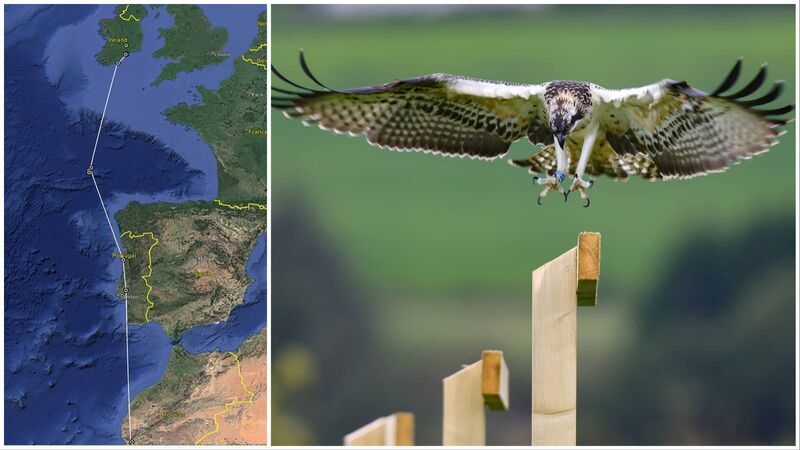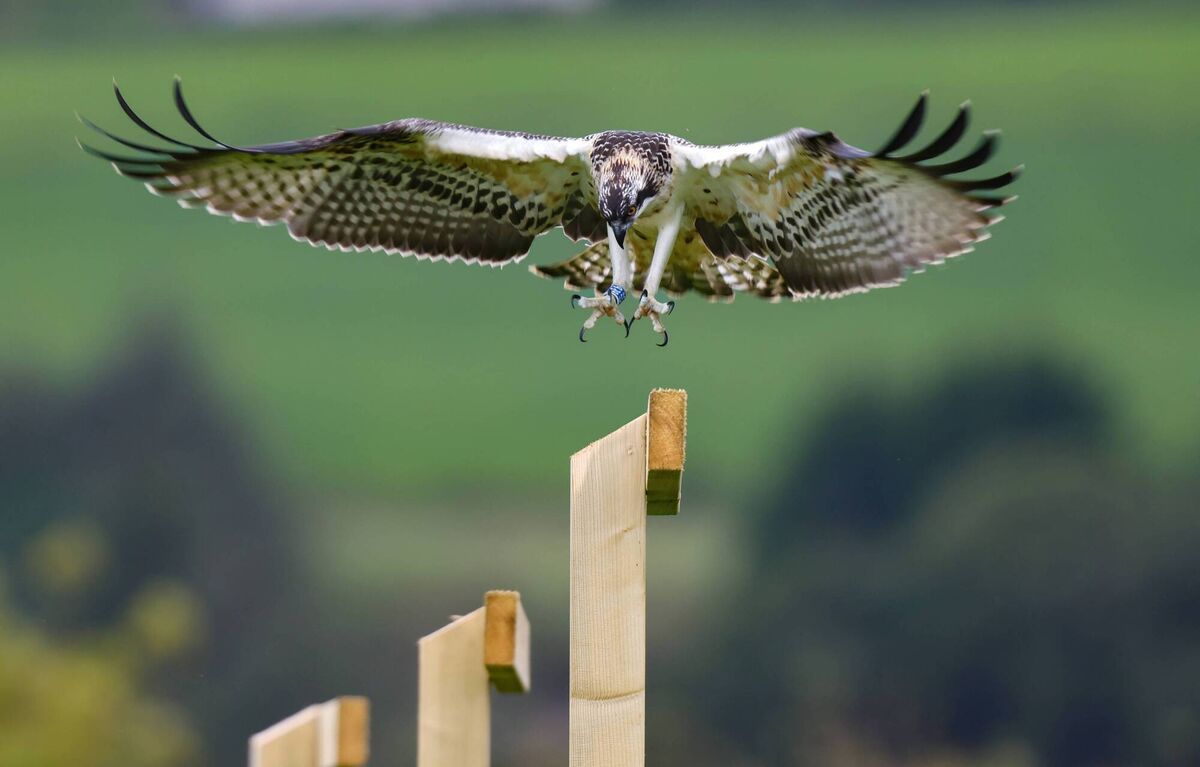From Dungarvan to Africa — one of the Osprey chicks released here has arrived in Morocco

The Osprey's incredible journey. Left: the route taken by the tagged and tracked Osprey which left Dungarvan on September 16 and was recorded in Africa on September 21. Right: Osprey photo by Valerie O'Sullivan
One of the first Osprey chicks released in Ireland by the National Parks and Wildlife Service (NPWS) in August has arrived in southern Morocco.
In August the NPWS released nine Osprey chicks into the wild. The chicks were brought from Norway and cared for by NPWS staff in the southeast of the country until they were ready to be released. The chicks continued to be fed and cared for in the area after their release, as they had become accustomed to their new habitat.
A key part of the programme involves the chicks being tagged before their release, so NPWS staff can track their movement and migratory pattern. Data generated by this satellite tagging system shows one of the chicks leaving the southeast of Ireland on September 16 and arriving in Africa on September 21.
Ospreys based in Northwestern countries such as Ireland generally migrate to equatorial Africa for the winter months. The chick left the southeast of Ireland and travelled south over the Bay of Biscay, flying over the northwest of Spain, down over Portugal and eventually arriving in southern Morocco. They are expected to continue on until they reach Nigeria.
Philip Buckley and Éamonn Meskell head up the reintroduction project for NPWS.
Dr Buckley said: "We now know that one of the birds ['named' 6E3] released has successfully made the journey to Africa — a journey of some 2,500 kilometres — at one stage at a speed of 32 km per hour. This is a significant, encouraging sign for the programme."

"The long-term aim of the programme is to establish a sustainable, breeding population of Ospreys in Ireland. Data is critical in helping us to measure the progress of reintroduction programmes like this," he noted.
Ospreys don't migrate in a flock as other birds such as swallows might — instead adult females depart first followed by adult males and then the juveniles travel on their own, explained Mr Meskell. They may stop along the way to feed in the Loire and at the Algarve.
"These birds would be expected to spend two to three years getting strong and feeding up in Africa and getting ready to travel back to Ireland and to mate," he said.
It is hoped that the nest platforms that were built for the birds in Waterford before they left will be considered their natal site now and that they will return here when they are ready. The male birds are the ones that set up the territory for mating and then a female passing by may stop and pair up.
A lot of credit for this successful start to the Osprey reintroduction programme goes to their Norwegian counterparts —
including the Norwegian Institute for Nature Research (NINA) — as they have also helped with the reintroduction of the white-tailed eagle here.

Ospreys are thought to have become extinct as breeding birds in Ireland more than 200 years ago but have continued to visit the island as part of their migratory pattern. The NPWS plans to bring 50 chicks to Ireland over a five-year period. And, a breeding pair of ospreys and their chicks was also discovered at a nesting site in Northern Ireland in August — a momentous, first sighting of naturally established, breeding ospreys in more than 200 years.
The NPWS used the learnings from its work with the white-tailed eagle to inform its work on reintroducing the Osprey. Over the past 16 years the NPWS has reintroduced 170 white-tailed eagles to Ireland, some of which are now fledging chicks.
Ospreys are fish-eating birds of prey which need habitats which are close to rivers, lakes or coastal areas which ensure a sufficient supply of fish. They are known to be monogamous and faithful to both their mate and their nest. They may have a lifespan of around 15 years.
The osprey tracking was recorded by ornithological researcher, Kendrew Coulhoon of KRC Ecological Ltd.
: Osprey with satellite tracker attached to its tail leaves Dungarvan and at 8am was 8km 106° (SW) of the Old Head of Kinsale. It had travelled on a bearing 224°(SW) 75km from Dungarvan at that point.
: The next cluster of fixes were at sea ~160km off Northwest Spain which meant it had travelled a further 700km on a 196° bearing (SSW) (32km/h on leg 1 and 2 combined).
: Bird was on North Portuguese coast (~50km N of Porto). It had travelled on a 160° bearing (S) a further 590km (24k/h)
: Bird was 40km north east of Lisbon, having travelled a further 190km on a 180° bearing (S) (8k/h).
Our latest position has the bird 950km further south in a different continent - location Morocco, again travelling at bearing 180° (S). Location was ~30km east of Agadir (so a little inland) which is ~ 170km southwest of Marrakesh (20k/h)

In all, the bird has travelled around 2470km from Dungarvan and seems to have had average speeds of 21km/h — but may have covered up to 35km/h or 500km/day.








